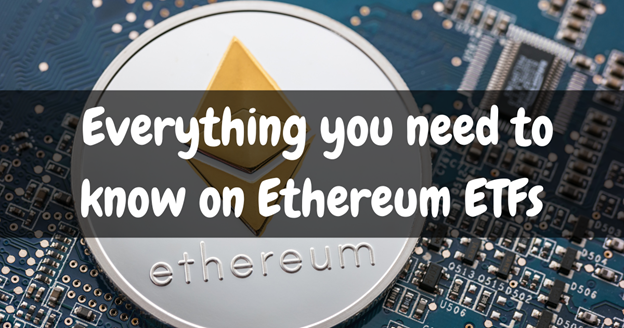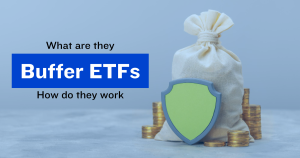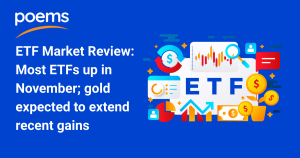Everything you need to know on Ethereum ETFs August 5, 2024

As the digital landscape continues to evolve, Ethereum has emerged as a cornerstone of the cryptocurrency revolution, second only to Bitcoin in market prominence. The introduction of Ethereum Exchange-Traded Funds (ETFs) marks a pivotal shift, bridging the gap between traditional investment mechanisms and the burgeoning world of cryptocurrencies. This new investment avenue promises to democratise access to Ethereum, allowing seasoned investors and novices alike to partake in the potential of this dynamic digital currency through conventional trading platforms.
With Ethereum ETFs, the complex and often daunting realm of cryptocurrency investment becomes more accessible, regulated, and integrated into the broader financial ecosystem. Let’s explore the advantages and challenges these innovative financial products present, shedding light on their potential to reshape investment strategies and influence the global acceptance of digital assets.
Brief History of Ethereum & Cryptocurrency
2009: Creation of Bitcoin
- Bitcoin was created by an individual known as “Satoshi Nakamoto”.
- lockchain technology was introduced for decentralised digital currency.
- Enabled peer-to-peer transactions without a central authority.
2013: Concept of Ethereum
- Vitalik Buterin conceived Ethereum.
- Aimed to use blockchain technology for decentralised applications (dApps).
- Introduced smart contracts for self-executing agreements.
Early 2014: Development of Ethereum Begins
- Co-developers: Gavin Wood and Jeffrey Wilcke.
- Funded through an initial coin offering (ICO).
- Raised over US$18 million in mid-2014.
30 July, 2015: Launch of Ethereum
- Ethereum’s first public release, known as Frontier, was launched.
2016: DAO Hack and Hard Fork
- A DAO on Ethereum was hacked, resulting in the loss of US$50 million in Ether.
- This led to a hard fork, creating Ethereum (ETH) and Ethereum Classic (ETC).
2017: Formation of the Enterprise Ethereum Alliance (EEA)
- EEA formed with blockchain startups, research groups, and Fortune 500 companies.
- Aimed to standardise and promote Ethereum’s use in enterprise settings.
September 15, 2022: Transition to Proof of Stake
- Ethereum transitioned from proof-of-work (PoW) to proof-of-stake (PoS).
- The upgrade, known as “the Merge,” significantly reduced Ethereum’s energy consumption.
Impact of Ethereum
- Became the second-largest cryptocurrency by market capitalisation.
- Enabled the development of decentralised finance (DeFi) applications, non-fungible tokens (NFTs), and various other dApps.
Broadened the scope of blockchain technology
Background and Significance of Ethereum Spot ETFs
What is an Ethereum Spot ETF?
An Ethereum spot ETF is an exchange-traded fund that tracks the price of Ethereum’s native token, Ether (ETH). Unlike futures ETFs, which track the price of Ethereum through futures contracts, spot ETFs hold the actual Ethereum tokens. This allows investors to gain exposure to Ethereum’s price movements without having to manage cryptocurrency wallets or navigate through exchanges.
Recent Developments
The US Securities and Exchange Commission (SEC) recently approved several Ethereum spot ETFs, marking a significant milestone in the cryptocurrency market. This follows the earlier approval of Bitcoin ETFs, which have attracted substantial investment since their debut.
Significance of Ethereum Spot ETFs
- Regulated Exposure: Ethereum spot ETFs provide a regulated investment vehicle for Ethereum, making it more accessible to traditional investors. This can attract institutional investors who may have been hesitant to invest in unregulated cryptocurrency markets.
- Ease of Access: These ETFs allow investors to buy and sell Ethereum through traditional brokerage accounts, simplifying the investment process and eliminating the need for technical knowledge about cryptocurrency management.
- Market Impact: The approval of Ethereum spot ETFs is expected to increase the inflow of capital into the Ethereum market. While some analysts predict that these funds could attract US$15 billion to US$20 billion in the first year, the impact may not be as significant as Bitcoin ETFs due to Ethereum’s lack of a strong narrative like Bitcoin’s “digital gold” status.
- Broader Financial Ecosystem: Ethereum ETFs bridge the gap between traditional finance and the cryptocurrency market, potentially leading to greater adoption and integration of blockchain technology in conventional financial systems.
Pros and cons of an Ethereum ETF:
Pros:
- Increased Accessibility:
- Lower Cost:
- Diversified Portfolios:
- Regulated Framework:
- Enhanced Liquidity:
An Ethereum spot ETF makes investing in Ethereum accessible to anyone with a brokerage account.
Investing in ETFs is generally more cost-effective. For example; investing in a Gold ETF incurs lower cost compared to physically buying and holding gold.
Investors can diversify their portfolios without the need to directly purchase Ethereum.
Spot ETFs provide a more regulated investment environment
They increase the liquidity of Ethereum investments by potentially attracting more market participants to the stock exchange
Cons:
- Limited Exposure:
- Market Volatility:
- Regulatory Challenges:
- Uncertain Future:
- Lack of Asset Backing:
Investors only gain exposure to Ethereum price, rather than a diversified portfolio of cryptocurrencies
Ethereum price exhibits high volatility, which may not be suitable for everyone.
The legal status of cryptocurrency is still evolving, which poses potential risks.
The long-term utility and acceptance of Ethereum remain uncertain.
Unlike traditional investments such as stocks or real estate, Ethereum lacks intrinsic value or physical backing, This characteristic makes it more speculative and dependent on market sentiment
Trading Ethereum ETFs
Trading Ethereum ETFs involves adhering to certain rules, such as completing the Customer Account Review (CAR), Risk Warning Statements and W8 Form (for US market trading). These steps ensure that investors understand the risks involved and know what they’re getting into. For a detailed overview of the available Ethereum funds and their associated fees, please refer to the table below.
| Fund name & symbol | Fee | Notes |
| Franklin Ethereum Trust (EZET) | 0.19% | Fee waived until January 31, 2025 or first US$10 billion in fund assets, whichever comes first. |
| VanEck Ethereum Trust (ETHV) | 0.20% | Fee waived for the first 12 months of trading or first US$1.5 billion in fund assets, whichever comes first. |
| Bitwise Ethereum ETF (ETHW) | 0.20% | Fee waived for the first six months of trading or first US$500 million in fund assets, whichever comes first. |
| 21Shares Core Ethereum ETF (CETH) | 0.21% | Fee waived for the first six months of trading or first US$500 million in fund assets, whichever comes first. |
| Fidelity Ethereum Fund (FETH) | 0.25% | Fee waived until Dec. 31, 2024 |
| iShares Ethereum Trust (ETHA) | 0.25% | Fee reduced to 0.12% for the first US$2.5 billion in fund assets. | Grayscale Ethereum Mini Trust (ETH) | 0.25% | Fee reduced to 0.12% for the first 12 months of trading or the first US$2 billion in fund assets, whichever comes first. | Invesco Galaxy Ethereum ETF (QETH) | 0.25% | N/A |
Sources: Ehttps://www.nerdwallet.com/article/investing/ethereum-etfs
SEC EDGAR system. Data is accurate as of 17 July, 2024 and for informational purposes only.
Conclusion:
The approval and launch of Ethereum spot ETFs represent a significant development in the cryptocurrency market. These ETFs provide a regulated, accessible way for both retail and institutional investors to gain exposure to Ethereum, potentially driving further investment and adoption of blockchain technology. As the market evolves, the impact of these financial instruments will likely become more pronounced, shaping the future of cryptocurrency investments.
Source
- https://www.nerdwallet.com/article/investing/ethereum-etfs
- https://www.theblock.co/learn/245716/a-brief-history-of-ethereum
- https://www.theblock.co/post/306703/heres-everything-you-need-to-know-about-spot-ethereum-etfs
- https://www.coindesk.com/business/2024/07/22/sec-approves-spot-ethereum-etfs/
- https://primexbt.com/for-traders/what-is-a-spot-ethereum-etf/
- https://101blockchains.com/importance-of-ethereum-etfs/
Additional Risk Disclosure Statement for Payment Token Derivatives (“PTDs”)
Trading in PTDs such as cryptocurrency funds or ETFs, cryptocurrency CFDs or debentures that reference payment tokens carries a high level of risk. The Customer may risk losing all the Customer’s capital or more. The Customer must therefore be fully aware of the following risks associated with both derivatives and payment tokens/cryptocurrencies and carefully assess whether an investment in PTDs or cryptocurrencies is suitable for the Customer’s investment objectives and risk appetite:
- Cryptocurrencies are not legal tender and are not issued by any government nor backed by any asset or issuer. Cryptocurrencies are currently not subject to any regulatory requirements or supervisory oversight by the Monetary Authority of Singapore (MAS). Hence the safeguards afforded under MAS’ regulatory framework may not apply to consumers dealing with unregulated products;
- Cryptocurrencies have little or no intrinsic value, making them hard to value and are extremely volatile. Being highly speculative, investing in them entails high risk as prices are prone to sudden sharp swings as a result of unanticipated events or changes in market sentiments primarily due to the lack of price transparency;
- Liquidity may also become limited and price gaps may occur in such circumstances;
- Cryptocurrency exchanges, where cryptocurrencies are bought and traded, may be susceptible to cyber security breaches. In the event of a cyberattack and theft of cryptocurrencies, it may result in drastic, adverse price movements.
Disclaimer
These commentaries are intended for general circulation. It does not have regard to the specific investment objectives, financial situation and particular needs of any person who may receive this document. Accordingly, no warranty whatsoever is given and no liability whatsoever is accepted for any loss arising whether directly or indirectly as a result of any person acting based on this information. Opinions expressed in these commentaries are subject to change without notice. Investments are subject to investment risks including the possible loss of the principal amount invested. The value of the units and the income from them may fall as well as rise. Past performance figures as well as any projection or forecast used in these commentaries are not necessarily indicative of future or likely performance. Phillip Securities Pte Ltd (PSPL), its directors, connected persons or employees may from time to time have an interest in the financial instruments mentioned in these commentaries. Investors may wish to seek advice from a financial adviser before investing. In the event that investors choose not to seek advice from a financial adviser, they should consider whether the investment is suitable for them.
The information contained in these commentaries has been obtained from public sources which PSPL has no reason to believe are unreliable and any analysis, forecasts, projections, expectations and opinions (collectively the “Research”) contained in these commentaries are based on such information and are expressions of belief only. PSPL has not verified this information and no representation or warranty, express or implied, is made that such information or Research is accurate, complete or verified or should be relied upon as such. Any such information or Research contained in these commentaries are subject to change, and PSPL shall not have any responsibility to maintain the information or Research made available or to supply any corrections, updates or releases in connection therewith. In no event will PSPL be liable for any special, indirect, incidental or consequential damages which may be incurred from the use of the information or Research made available, even if it has been advised of the possibility of such damages. The companies and their employees mentioned in these commentaries cannot be held liable for any errors, inaccuracies and/or omissions howsoever caused. Any opinion or advice herein is made on a general basis and is subject to change without notice. The information provided in these commentaries may contain optimistic statements regarding future events or future financial performance of countries, markets or companies. You must make your own financial assessment of the relevance, accuracy and adequacy of the information provided in these commentaries.
Views and any strategies described in these commentaries may not be suitable for all investors. Opinions expressed herein may differ from the opinions expressed by other units of PSPL or its connected persons and associates. Any reference to or discussion of investment products or commodities in these commentaries is purely for illustrative purposes only and must not be construed as a recommendation, an offer or solicitation for the subscription, purchase or sale of the investment products or commodities mentioned.
About the author
MuMing Yong
ETF Specialist
Phillip Securities Pte Ltd
Mu Ming traded and invested for more than 8 years in various instruments including ETFs, Equities, Unit Trusts, Options, DLC, CFD, and ILP from the US, SG and HK market. He's a believer of personal finance, macroeconomics, and, technical analysis - so much so that he found himself analysing his social media engagement using trend lines and patterns.

 Buffer ETFs — What Are They and How Do They Work?
Buffer ETFs — What Are They and How Do They Work?  ETF Market Review: Most ETFs up in November; gold expected to extend recent gains
ETF Market Review: Most ETFs up in November; gold expected to extend recent gains  Should You Invest Your Supplementary Retirement Scheme (SRS) Savings?
Should You Invest Your Supplementary Retirement Scheme (SRS) Savings?  Factor-Based (Smart-Beta) ETFs: How They Work, Selection Criteria, and Practical Uses for Singapore Investors
Factor-Based (Smart-Beta) ETFs: How They Work, Selection Criteria, and Practical Uses for Singapore Investors 




